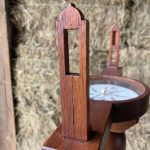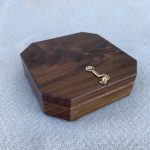What’s New items handmade in the 18th century manner
All of these Wooden Surveyors Compasses and chains are in stock and ready to ship now. For a shipping quote, please e-mail me with your shipping address and the item number of what you are interested in.
Wooden Surveyors Compass
This is a copy of an 18th century circumferentor or wooden Surveyors compass on a three legged staff which are made from mahogany. Dimensions of the body are 15″ long, 6-3/8″ wide and the height of sight bars are 4-3/4″ the sighting hair is black horse hair. I copied the compass card from an original New England Compass. (circa 1760) It illustrates an 8 point compass rose with a traditional Fleur-de-lis at North. The needle ring is divided 0-90 degrees in four quadrants. I make the needle from .025 thick tool steel and hand filed to balance on the 5/32″ iron pivot and it is 6 13/16″ long. I first turn the brass needle hub to create the interior pivot and then cut and file it to create the wing protrusions.
The glass protecting the card is Bendheim full restoration glass which is using the authentic mouth-blown cylinder glass technique. It exhibits surface distortion and the occasional air bubble, while the glazing used to retain the glass is Allback linseed oil glazing putty. It is simply purified organic linseed oil and whiting (Calcium Carbonate) I stained this compass with a brown mahogany dye, applied a coat of shellac and then put a glaze over that to give a more aged look and further protected it with a blend of Oil and Varnish. I also provide a box to protect and store the Compass in which is made from mahogany. It has hand cut dovetail corners with nailed top and bottom. The box measures 8″ deep x 17″ wide x 9″ high
$1950.00 Item # 2000 SOLD
Wooden Surveyors Compass
This is a copy of an 18th century circumferentor or wooden Surveyors compass on a three legged staff which are made from maple. Dimensions of the body are 15″ long, 6-3/8″ wide and the height of sight bars are 4-3/4″ the sighting hair is black horse hair. I copied the compass card from an original New England Compass. (circa 1760) It illustrates an 8 point compass rose with a traditional Fleur-de-lis at North. The needle ring is divided 0-90 degrees in four quadrants. I make the needle from .025 thick tool steel and hand filed to balance on the 5/32″ iron pivot and it is 6 13/16″ long. I first turn the brass needle hub to create the interior pivot and then cut and file it to create the wing protrusions.
The glass protecting the card is Bendheim full restoration glass which is using the authentic mouth-blown cylinder glass technique. It exhibits surface distortion and the occasional air bubble, while the glazing used to retain the glass is traditional whiting and shellac, simply dewed shellac and whiting (Calcium Carbonate) I painted this compass with two coat of blue milk paint, made by the old fashioned milk paint Company and further protected it with a blend of oil and varnish. I also provide a box to protect and store the compass in which is made from white pine and left raw. It has hand cut dovetail corners with nailed top and bottom. A simple iron handle and hasp finish out the box.
$1500.00 Item #2301 SOLD
Turned Wooden Compass
This portable compass is incased in a turned walnut lidded box. The compass card illustrates a 32-wind compass rose with a traditional Fleur-de-lis at North. The needle ring is is divided 0-360. The steel needle is balanced on a brass hub with wing protrusions. This is covered by a piece of handblown glass and kept in place by a brass retaining ring. It has a shellac finish.
Box is 4-1/2″ dia. x 1-3/8″ h
$395.00 / Item # 2003
Cased Wooden Compass
This portable compass has a walnut flat hinged cover held closed with a brass pin and clasp. The compass card illustrates a 16-wind compass rose with a traditional Fleur-de-lis at North. The needle ring is is divided 0-90 in four quadrants. The steel needle is balanced on on a brass hub with wing protrusions. This is covered by a piece of handblown glass and kept in place by a brass retaining ring. It has a Shellac finish.
Box is 4-1/2″ w x 1-1/4″
$395.00 / Item # 2004
Gunters Surveyors chain (half)
The surveyor’s chain is also called a Gunter’s chain because it was invented by Edmund Gunter (1581-1626) an English mathematician. A full chain is 66′ long, consisting of 100 links or 33′ for a half chain (50 links) This chain is copied from an original 18th century chain. It has no brass markers and is a half chain (33′ long.)
Item # 2005 $225.00 without brass tellers $250.00 with brass tellers
Samuel Lane surveyors chain (half)
The surveyor’s chain is also called a Gunter’s chain because it was invented by Edmund Gunter (1581-1626) an English mathematician. A full chain is 66′ long, consisting of 100 links or 33′ for a half chain (50 links) This chain is copied from an original 18th century chain, including the brass tags or markers that are set at 10 link intervals, one finger for 10 links, 2 fingers for 20 links. This is a half chain (33′ long.)
Item # 2006 $225.00 without brass tellers $250.00 with brass tellers





















